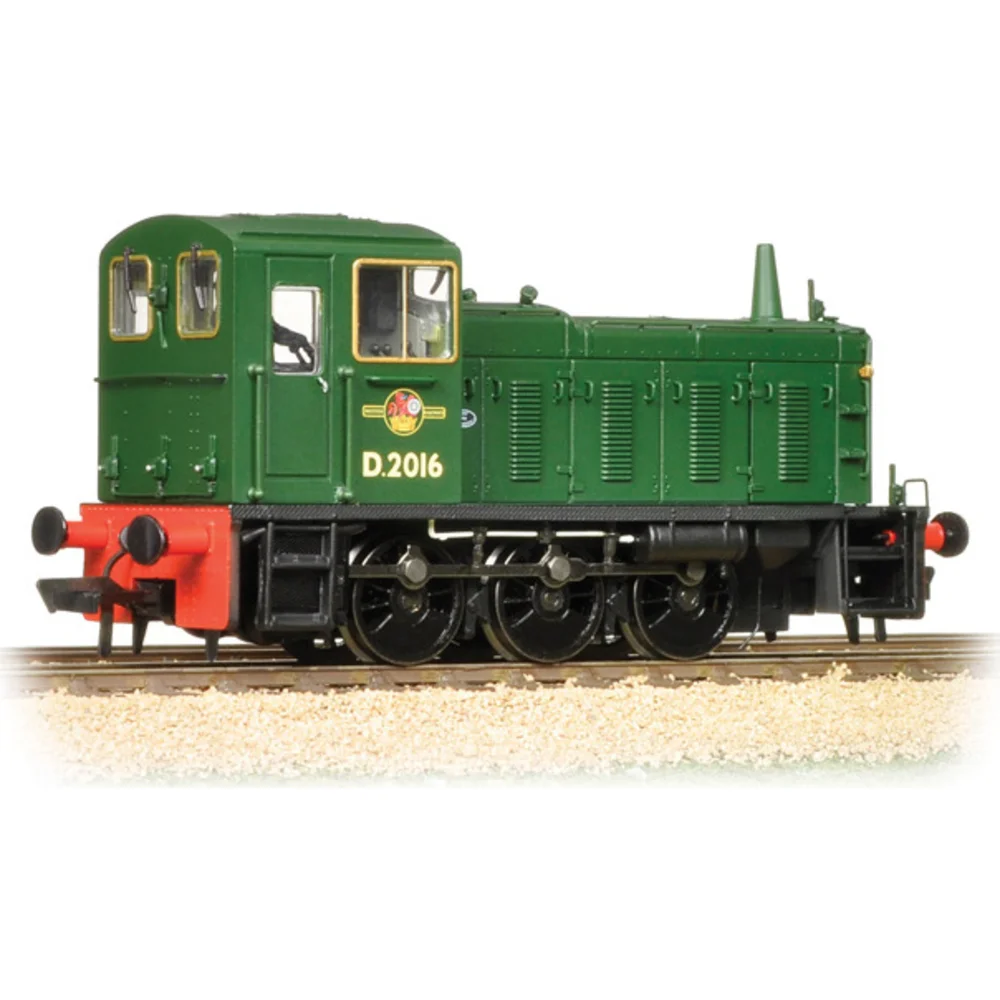Bachmann 31-366
British Rail Class 03 D2016 British Railways Green with Late Crest
Tooling
In 2010, Bachmann introduced an upgraded Branchline tooling for their OO gauge British Rail Class 03 shunter. This marked a significant evolution over the late 1990s ex-Mainline tooling, bringing coreless motors, enhanced detailing, and DCC-ready features to a model that had enjoyed great popularity. The upgrade bridged the gap between traditional analogue operation and modern digital flexibility, while maintaining scale fidelity and value.
Tooling Features
- Scale: OO gauge (1:76), first-radius curves (371 mm) capable.
- Construction: High-fidelity plastic bodyshell with separately-fitted items — handrails, chimney, roof-mounted horn, lamps, and windshield wipers. Chassis is die-cast with integrated split-frame design.
- Detailing: Engine cab interior complete with seated driver, glazing, underframe pipework, sandboxes, buffer beams, and accurate jackshaft mechanism visible from the chassis.
- Couplings: Fitted with NEM pockets. Standard tension-lock couplings removable in favour of deep buffer beam plates and scale couplings.
Mechanical & Electrical
- Motor & Drive: Installed with a coreless motor for more reliable low-speed performance; traditional jackshaft drive retained.
- Pickups & Wheels: Pickups on both wheels of each axle ensure good traction; all wheels driven and die-cast chassis provides essential weight.
- Minimum Radius: Handles first-radius curves (371 mm) with ease.
- Lighting: DCC operation supports cab lighting; analogue models remain without built-in lighting.
- Weighting: Heavier chassis delivers consistent traction and hauling capacity.
DCC Capability
- Comes factory-equipped with a 6-pin decoder socket, ready for DCC installation.
- Versions included "DCC Ready" format; a “sound-fitted” variant with factory-installed ZIMO decoder and speaker is available.
- Optional speaker space allows retrofitting of third-party sound and stay-alive decoders.
Liveries Produced
The 2010 tooling was offered across a range of authentic liveries, including:
- BR green with late crest (1957–1972)
- BR blue “wasp stripes” (1965–1990)
- Network Southeast (1986–1994)
- WAGN (1997–2006)
- British Army/MoD variations
Reviews & Commentary
- Reviewers consistently praised the smooth, quiet operation courtesy of the coreless motor and enhanced gearbox tolerance.
- Detailing was applauded — notably flush glazing, separate handrails, and precise paint finishes.
- Some users flagged occasional mechanical noise in early batches, usually remedied via lubrication and running in.
Media & Social Media Insights
- YouTube “unboxing & review” videos highlight improved mechanical smoothness, DCC readiness, lighting, and overall visual fidelity.
- Forum discussions on RMweb and similar sites focus on the ease of fitting decoders and sound upgrades, and note strong performance on compact layouts thanks to first-radius capability.
- Owners often report that the factory-fitted sound variant delivers excellent audio realism combined with reliable mechanical performance.
Other Interesting Information
- Accessory packs include buffer beam plates and scale coupling kits to replace tension locks.
- A recommended 30–60 minute running-in on moderate speed helps smooth gearbox and drive components.
- Placing a stay-alive device (e.g., capacitor pack) inside the cab improves power pickup and stall resistance during shunting.
- The tooling remains a popular choice for small, realistic shunting layouts and has set a standard for later Bachmann diesel retooling.
Class & Prototype
- Class: British Rail Class 03
- Traction: Diesel
- Transmission: Mechanical
- Built: 1957-1961
- Total Built: 230
The BR Class 03 was British Railways' standard light diesel-mechanical shunter, with 230 built at Doncaster and Swindon Works between 1957-1962. Powered by the legendary Gardner 8L3 engine and featuring distinctive jackshaft drive with coupling rods, these 30-ton locomotives excelled on weight-restricted lines, docks, and industrial sidings where heavier Class 08s couldn't operate. Notable variants included nine cut-down cab examples for the Burry Port & Gwendraeth Valley Railway and two for Isle of Wight tunnel clearance. With 56 preserved (24% survival rate) and the last example working until 2008, the Class 03 remains popular with heritage railways and modellers alike.
No prototype found.
Operator & Livery
- Operator: British Railways
- Livery: Green with Late Crest
British Railways transformed Britain's fragmented rail network into a unified national system following nationalisation on 1st January 1948. Created from the "Big Four" companies under the Transport Act 1947, BR operated most of Great Britain's railways until rebranding as British Rail in 1965, managing over 20,000 route miles and inheriting nearly 20,000 locomotives of diverse designs.
The organisation pioneered standardisation through its revolutionary BR Standard locomotive programme (1951-1960), producing 999 advanced steam engines under Robert Riddles' direction. These included the versatile Britannia Pacifics, mighty 9F freight engines, and mixed-traffic classes that incorporated the best features from all predecessor companies. The 1955 Modernisation Plan accelerated diesel and electric traction development, creating fascinating mixed-traction operations.
Notable achievements included establishing unified locomotive classification systems, introducing distinctive corporate liveries, and managing the complex transition from steam to modern traction. BR's six regional structure preserved operational diversity whilst enabling standardisation of practices, signalling, and rolling stock that had eluded private enterprise for over a century.
The BR era represents steam traction's final flowering alongside emerging diesel technology, creating unparalleled locomotive variety. Today, this heritage remains highly popular with railway enthusiasts through extensive preserved fleets, heritage railway operations, and comprehensive model ranges from manufacturers like Hornby, Bachmann, and Dapol, making BR subjects essential for authentic post-war British railway modelling across all scales.
